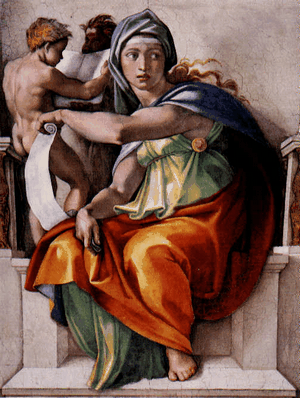Almost every culture in the world has reserved a special place in society for people believed to have been endowed with prophetic powers. The ancient Greco-Roman world had a few such prophetic traditions. One of the best-known is that of the Sibyls. It was believed that, when she entered into an entranced state, a Sibyl came under the influence of a certain deity and would often make surprisingly accurate predictions. There is no denying the strong similarities between the ancient Sibyls and their trance states with psychics of the modern era who utilize trance mediumship. This is why the ancient word ‘sibyl’ was (and sometimes still is) used interchangeably with the word ‘psychic’.
Delphi was ancient spiritual community in Greece which is thought to be the historical site for the sibylline traditions. It was the location of not only the Delphic Sibyl, but also the Oracle of Delphi. The general public is perhaps more familiar with the Oracle of Delphi, and many people often assume that the Delphic Sibyl and the Delphic Oracle were the same person. This is not true. The two were entirely separate.
The Oracle of Delphi, which was a shrine to Apollo, brought messages to men from the gods through a priestess and existed from 1400 BC to 400 AD. The Delphic Sibyl began issuing prophecies from a different location around 500 BC. It should be noted that historians are in disagreement about which institution came first. Some argue that there is evidence that Sibyl of Delphi pre-dates the Oracle of Delphi temple.

"So revered was the Delphic Sibyl that Michelangelo included a depiction of her within the Sistine Chapel… "
What we do know for sure is that the locations of these two psychic groups is very well established. The Oracle, who went by the name of Pythia and who was the official priestess of Apollo, delivered her prophecies inside the Temple of Apollo. The Delphic Sibyl, on the other hand, is said to have prophesied from Sibyl rock, a pulpit-like rock outcrop which was near to but outside of the temple itself.
So, Who Was the Delphic Sibyl?
Our most important source for historical information on the Delphic Sibyl is Pausanias, a 2nd century Greek traveler who wrote about his exploration of the Greek world. Pausanias mentions the Delphic Sibyl at length in his most famous work, Descriptions of Greece. He begins by describing Sibyl rock and reporting the Delphian’s claim that on that rock there once "stood and chanted the oracles a woman, by name Herophile and surnamed Sibyl".
Herophile, writes Pausanias, was "clearly born before the Trojan war". Some claimed that she was the daughter of a shepherd named Theodorus, and that she was born in a cave on Mount Corycus near the city of Erythrai. When she grew up she became an attendant at the Temple of Apollo Smintheus at Alexandria. It was said that, while an attendant in the Temple, Herophile uttered her first prophecy. Herophile then seems to have left the Temple and spent most of her life on the Greek island of Samos. Now considered a ‘sibyl’, Herophile would travel and visit the cities of Clarus, Delos, and Delphi. When she returned to Delphi, Pausanias recorded that she would stand on Sibyl rock and "sing her chants" of prophecy.
Mythology Surrounding the Delphic Sibyl
There is a good deal of fog, confusion and mystery in Greek mythology about the true parentage of Herophile. Naturally, this has lead to a good deal of debate among scholars as to what is, or is not, true about the First Sibyl. A quick search through online resources (and even written sources) will likely leave you with the impression that legends about Herophile cannot agree on whether she was the daughter of a man, a nymph, or the offspring of a god.
Some of this confusion goes back, again, to the Greek historian Pausanias. He, in fact, records two different Delphic Sibyls. There is the historical Herophile who claimed that her father was a human and that her mother was an immortal nymph. Then Pausanias also mentions an even earlier "ancient" Sibyl. This ancient Sibyl, so far back in the mists of history that we know almost nothing about her (and apparently neither did Pausanias). It was said this ‘ancient Sibyl’ was fathered by Zeus and born to Lamia, the daughter of Poseidon. She seems more mythological – the original Sibyl – who is part of the pantheon of the original Greek gods. It is difficult to say if she was real or not. It is likely Pausanias saw Herophile as continuing on the tradition of this mysterious, ancient, First Sibyl.
Pausanias further writes that Herophile identified herself with the goddess Artemis. And, that Herophile claimed to be both the sister and the wife of the god Apollo. In Greek mythology, Artemis is variously depicted as the older sister, the twin sister, and even the wedded wife of Apollo. She often represents the female side of divinity while Apollo represents the male.
The Delphic Sibyl’s Most Famous Predictions
Unfortunately, though she would have made numerous prophetic utterances atop Sibyl rock, all but two of Herophile’s predictions have been lost to time.
One of these predictions concerned a struggle between the Spartans and the Argives for control over a district known as Thyrea. Herophile predicted this conflict would end in a draw. In a paper titled Trial by Combat among the Greeks A. MacC. Armstrong writes that the initial fight did indeed end in what could be considered a draw. Later in history the Spartans would eventually gain control Thyrea.
Herophile was best known throughout the ancient world for her other prediction: The fall of Troy in the Trojan War. According to Pausanias, she foretold that Helen of Sparta would be the "ruin of Asia and of Europe", and that it would be because of her that the Greeks would set out to capture the City of Troy.
For centuries it was though that the city of Troy and the Trojan War was ALL mythology and legend – that was until the actual city of Troy was found exactly where ancient Greek history said it would be. Much the same thing has occurred with the ancient Sibyls – the first psychics – that they were all mythological – until historical and archaeological evidence revealed that these psychic women were real.
Was the Delphic Sibyl the First Sibyl?
There is no doubt that the Delphic Sibyl was (and continues to be) one of the most well-known of the ancient Sibyls – the psychic women who were integral oracles in the history of ancient Europe.

Do you have questions about life, career, relationships, the future? Talk to Psychic Sadia, today, at: 1-866-407-7164 – Toll Free U.S. and Canada
The question is, was Herophile, Sibyl of Delphi, the first of the Sibyls? Many scholars seem to think so (but there is no universal consensus on the issue). Some researchers argue that it was the Sybil Erythraean, and not the Delphic Sibyl, came first. Others still, such as Anke Holdenried in her book "The Sibyl and Her Scribes", contend that the first Sibyl was the Persian Sibyl.
Though the origin and history of the Sibyls is shrouded in mystery, the Delphic Sibyl left one of the most indelible marks on the tradition. From her pulpit of stone she provided people with an important spiritual link to higher beings. Her life, the legends about her life, and her predictions about some of the ancient world’s most prolific events transformed her into a respected and revered figure whose legacy has lasted for a millennia.
Resource Links:
Info on Pausanias
Pausanias’ Descriptions of Greece
Debate on the oldest Sibyl – Book
Mythology Surrounding the Delphic Sibyl – Book
Prediction about Troy – Book
The Sibyl and Her Scribes – Book
